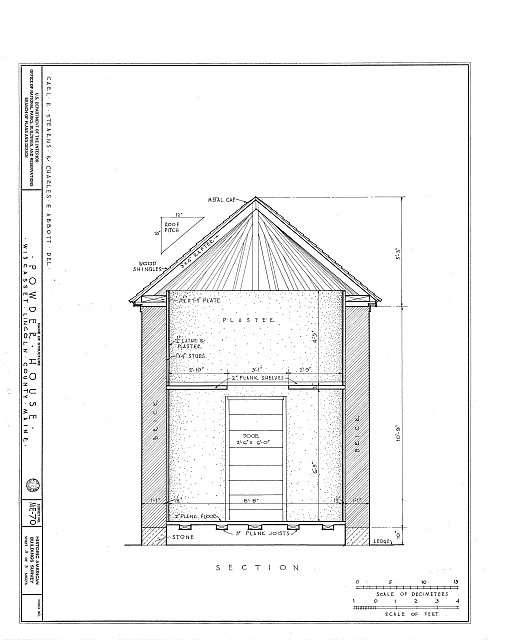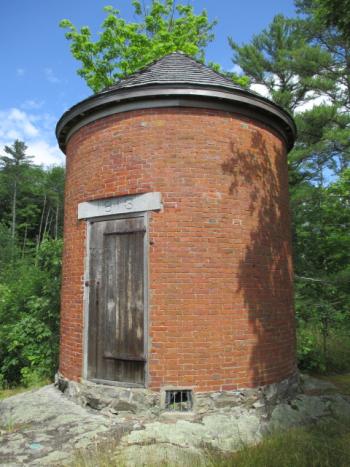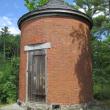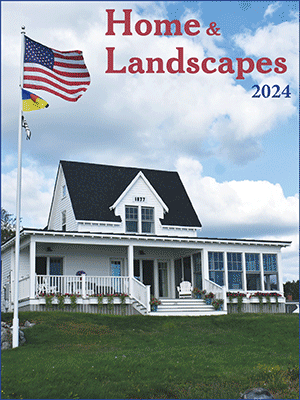Discovering Wiscasset’s 1813 Powder House
 Wiscasset’s 1813 Powder House off Churchill Street at it looks today. PHIL DI VECE/Wiscasset Newspaper
Wiscasset’s 1813 Powder House off Churchill Street at it looks today. PHIL DI VECE/Wiscasset Newspaper
 An engineering plan showing an interior view of Wiscasset’s 1813 Powder House. Courtesy Library of Congress, Washington, D.C.
An engineering plan showing an interior view of Wiscasset’s 1813 Powder House. Courtesy Library of Congress, Washington, D.C.
 Wiscasset’s 1813 Powder House off Churchill Street at it looks today. PHIL DI VECE/Wiscasset Newspaper
Wiscasset’s 1813 Powder House off Churchill Street at it looks today. PHIL DI VECE/Wiscasset Newspaper
 An engineering plan showing an interior view of Wiscasset’s 1813 Powder House. Courtesy Library of Congress, Washington, D.C.
An engineering plan showing an interior view of Wiscasset’s 1813 Powder House. Courtesy Library of Congress, Washington, D.C.
Visitors to Maine’s Prettiest Village often ask about Wiscasset’s Old Powder House. How do I find it? Why was it built? What’s inside it?
The Powder House, built in 1813, sits almost unnoticed on a small hill overlooking Churchill Street. In the summer only its pointed peak is visible through the trees. A sign alongside the road leads visitors on a short climb to it up a stone stairway.
Seeing it for the first time, people often say it looks like a rocket — tall, round with a cone-shaped wooden roof. It has no windows where you can peak inside. Its heavy plank door has many generations of initials carved into it and sits on hinges that were hand-forged.
The door is tightly secured to keep would-be curiosity seekers at bay. If you could go inside, you’d see its circular wall is finished off with plaster from the floor to the roof line. There’s no ceiling but there’s a small loft to make better use of the space.
The building is empty now, but not many years ago it was still used.
Selectman Ben Rines Jr. remembers in the 1960s and ’70s when the town stored its Fourth of July fireworks there. Rines grew up just down the road and spent many summer afternoons playing and camping out by the Powder House.
“The Powder House is one of the least known but best places to visit in Wiscasset,” Rines said, adding the building was included on the National Historical Register in 1973.
The Powder House is one of Maine’s three surviving powder magazines from the 19th century. The others are in Hallowell and Buxton but Wiscasset’s is the most unique. It’s the only one that’s round. All three were built during the War of 1812.
During American’s second war with Great Britain, Wiscasset like so many other Patriotic communities answered the call to the colors by raising a company of men to join the militia. Volunteers furnished their own firearms, camp gear and uniform but the town provided ammunition consisting of shot and gunpowder.
At Wiscasset’s town meeting of May 1813 voters appointed Gen. David Payson, Col. Ezekiel Cutter and Maj. Thomas McCrate, all Wiscasset volunteers, to find a suitable location near the village to erect a building for the safe storage of gunpowder. The building had to be in a place that couldn’t be easily found and targeted by the British.
General Payson, a wealthy and respected citizen, lived on High Street in a stately home that still stands across from the Wiscasset Public Library. Payson later sold the home to Samuel Emerson Smith, who served as Governor of Maine from 1831 to 1834. Col. Cutter, another of the town’s leading citizens, was a sail-maker by trade and is interred in the Ancient Cemetery.
By the first week in June, Gen. Payson had found the ideal spot, a rocky knoll away from the village and safely out of range of a British Naval attack. The location was near what in Colonial times served as the main road out of town.
The property owner, Jeduthan Boynton, agreed to sell a 20-foot square lot for $20. The deed included a “perpetual right-of-way for the inhabitants of Wiscasset” from any place along the road to the powder house site. Construction began almost at once under Col. Cutter’s supervision and the work was finished in September.
Among the bills was 60 cents to buy rum on Aug. 24, 1813 to celebrate the raising of the Powder House roof. That means in just a few weeks the Powder House will be 203 years old!
Eight thousand bricks were used to build the Powder House. They were fired locally at Henry Cargill’s brickworks. Cargill was paid $48 for the bricks that sold for $6 a thousand! The mason hired to build it was Nehemiah Somes whose other handiwork can be seen in a number of Wiscasset’s historic homes. Somes also did the interior plasterwork. Blacksmith John Warren furnished the hinges, hasp and studs for the plank door.
Steve Christiansen of Willow Lane shared something interesting about the Powder House. He said it was the Wiscasset Fire Society that added the granite header over the door with 1813 inscribed in it. The tablet was added when the Fire Society restored the building in 1905.
A good deal of the historical facts concerning the Powder House are contained within a slim pamphlet Christiansen lent the newspaper. It’s titled the “Proceedings of the Wiscasset Fire Society at its 419th quarterly meeting held July 20, 1905.” The society has been around since 1801 and is still going strong, meeting once each year.
“(T)he building has been carefully repointed with Portland cement; a new casing for the door has been put in with a yellow pine door stool, the door itself has been thoroughly strengthened by a 12-inch strip nailed around the inside with proper braces running across,” read the proceeding.
The timber floor was replaced and repairs also made to its plaster wall and roof.
In the 1930s, the Powder House and a number of other historical Lincoln County buildings were included in the Historical American Building Survey conducted by the National Park Service Department of Interior in Washington, D.C.
You can view architectural plans of the Wiscasset Powder House by visiting the Library of Congress at http://www.loc.gov/pictures/item/me0106/
Event Date
Address
United States
























